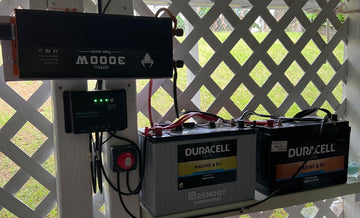Solar power systems have also become an efficient and clean option to meet our growing energy needs. As an important part of a solar system, inverters convert direct current (DC) into alternating current (AC) needed by the household. However, inverters can cause various inverter failures during daily use. Understanding and solving these problems is critical to maintaining your solar system. Here are some common failures and their solutions:
Common inverter failures
Inverter not turning on
The inverter may stop working when the grid is disconnected. (Except for some solar systems with a backup power function) Causes and solutions for the inverter not turning on:
Reason:
- Disconnected or loose wires
- Tripped circuit breaker
- Faulty power switch
Solution:
- Check all cables to make sure they are tightly connected
- If any of the fuses are blown, replace them immediately
- Bad power switch, get it checked by a professional
No display on the inverter screen
Under normal conditions, DC power is being supplied to the inverter. Wait a few minutes to ten minutes for the inverter to start up and initialize. The inverter screen normally displays the following information via text or indicator lights:
- System status: Normal operation, initial mode, or fault status of the solar system.
- Current and voltage information: Displays information on the current and voltage of the DC power generated by the solar panels and the AC power converted by the inverter.
- Power information: The current power generation and output power of the solar system.
- Energy Output: Displays the energy output of the solar system, usually in kilowatt hours (kWh).
- System Efficiency: Shows how efficiently the solar energy is being converted into electricity.
- Temperature Information: Ensures that the system is within safe operating limits.
- Error messages: If the system detects an error or problem, the screen may display the appropriate error code or diagnostic message.
- Date and time: Some navigators display the current date and time.
- System settings: There may be menu options that allow the user to view and change backlight settings, such as language settings, brightness settings, etc.
Failures and solutions if the inverter is unable to display:
Reason 1: Power failure
Solution: Check that the power switch is on, and then check that the wiring of the inverter is connected correctly, making sure that the positive and negative poles are not connected incorrectly.
Reason 2: Incorrect settings of the inverter may cause the screen not to be displayed.
Solution: Adjust the inverter settings. The brightness setting is too low, the language setting is wrong, or there are other setting problems.
Reason 3: The DC input voltage received by the inverter is too low. A multimeter can be used to check the input voltage to the inverter.
Solution: Ensure that the solar panel is absorbing enough light.
Inverter overload
Reason 1: Each inverter has a fixed power rating. The power of the connected load is too high and exceeds the rated load of the inverter.
Solution: Reduce the load of the solar system or increase the capacity of the inverter.
Reason 2: There may be short circuits in the solar system, causing excessive current to flow through the inverter, resulting in current overload.
Solution: Check the connections. Fix the short-circuit problem.
Reason 3: The ambient temperature is too high, causing the inverter to trip the overload protection.
Solution: Improve heat dissipation by changing the mounting position of the inverter.
Inverter battery is low
Reason 1: Battery aging or damaged, capacity reduced
Solution: If your battery has been used for more than five years, replace it with a new one.
Reason 2: Too much load causing the battery to discharge too quickly
Solution: Reduce the number of connected devices to conserve battery life
The inverter makes abnormal noise
Reason 1: Components inside the inverter (e.g. fan, rectifier, etc.) may be faulty or damaged, resulting in noise during operation.
Solution: Clean surface contamination and ventilation holes regularly to ensure there is no dust or debris. If cleaning is not possible, try replacing the fan.
Reason 2: The turbine may vibrate during operation, causing the casing or internal parts to rub against each other and make noise.
Solution: Use vibration damping pads or other damping materials to reduce vibration transmission and noise generation.
Inverter trip
Reason 1: An overvoltage or undervoltage condition in the system may cause the inverter to trip to protect the equipment.
Solution: Check the voltage condition, you can install a voltage stabilizer or voltage protection device.
Reason 2: Abnormal current trips to the inverter's protection mechanism.
Solution: Reset the inverter manually
Error code display on inverter
Reason 1: Software malfunction or update problem may cause the display to show an error code.
Solution: Try updating the software version of the inverter to resolve any software problems.
Reason 2: The Forecaster may not be able to communicate with the monitoring system or other devices.
Solution: Check the communication connection between the inverter and the monitoring system or other devices. Try reconnecting or replacing the connection cable.
Reason 3: Voltage spikes, surges, or fluctuations can trigger fault codes.
Solution: Installing an optional voltage stabilizer can help stabilize the voltage and protect the unit from voltage spikes and fluctuations.
Grounding Fault
Reason: There are many reasons for earth faults, such as wet and corroded earth electrodes, broken and loose earth wires, etc.
Solution:
- Check the earth wire and earth electrode for damage.
- Check that the earth resistance is within the normal range to ensure that the earthing system is operating normally, and repair damaged parts promptly.
- Remove dirt and corrosion from the earthing area to keep the earthing system dry and clean.

Preventive maintenance of inverters
After learning about common inverter failures and solutions, it is clear that routine maintenance is critical for solar inverters. Here are some common maintenance tips to ensure your solar system runs efficiently and reliably:
Regular cleaning: Clean the surface of the inverter and the surrounding area regularly to keep the inverter clean and dry.
Check cables and connections: Check cables and connections regularly for short circuits, damage, or corrosion. Ensuring good connections can prevent electrical faults.
Test data: Regularly monitor the inverter's performance data, including input and output voltages, currents, and other parameters. Early detection of anomalies can lead to action to prevent damage.
Firmware updates: Monitor firmware updates released by the manufacturer and follow the instructions. New firmware may contain performance improvements or bug fixes.
Annual professional inspection: Consider scheduling an annual inspection by a professional technician to ensure that all components of your solar system are working optimally!
Best 2000W Pure Sine Wave Inverter

No more fear of failure when choosing a high-quality inverter. TOPBULL offers you a wide range of inverters including pure sine wave and corrected sine wave, all with a one-year warranty!
🔥100% continuous output with up to 4000 watts peak surge power. Pure sine wave technology protects your electrical equipment.
🔥100% pure copper high-frequency transformers and ultra-flexible cables for low power conversion losses, low no-load power consumption, and high power conversion efficiency.
🔥Seven protection functions. Robust aluminum chassis with dual intelligent fans for no heat generation, low noise, and long product life.
🔥Built-in 1 USB port, 1 type-C port, and 2 AC sockets, 20-foot wired remote control to meet your diverse power needs.
Conclusion
Routine maintenance of your inverter is key to the efficient operation of your solar system. By understanding common inverter failures and their solutions, you can resolve many of these challenges yourself to ensure continued energy production.
Remember that safety is paramount and always consult a professional when faced with complex problems or electrical hazards. Regular preventive maintenance will extend the life of your solar system and allow you to enjoy the benefits of clean, renewable energy for years to come.

















